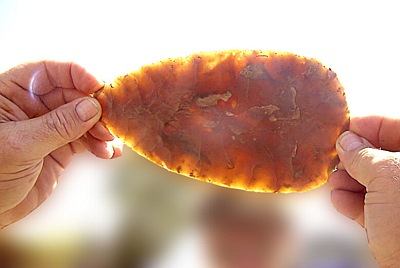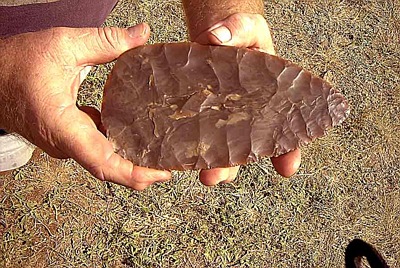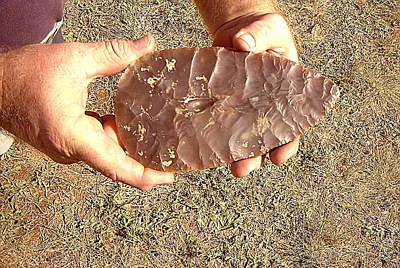If you are interested in purchasing this piece please visit our gallery at http://pinterest.com/modernknapping/
Friday, October 19, 2012
Auger with hole
Below is a dacite Auger needle with a hole through it for the threading of sewing material. In the past Bill has put bigger holes through knife blades(which I need to get pictures of on here) but he has never tried it on an Auger needle. These needles are very delicate and getting a hole through without breaking is not easy.
If you are interested in purchasing this piece please visit our gallery at http://pinterest.com/modernknapping/
If you are interested in purchasing this piece please visit our gallery at http://pinterest.com/modernknapping/
Sunday, October 14, 2012
Saturday, September 22, 2012
Clovis
This clovis is made of english flint. It is 8 inches long 2 1/2 inches wide and I estimate it ranges from 3/8 to 1/2 inch thick.(did not measure it with fowler gauge). It is fluted on both sides, one is 3 inches and the other is 2 inches. The top picture shows the flute spalls. It was fluted by free hand percussion using the atlatl method.
If you are interested in purchasing this piece visit http://pinterest.com/modernflintknapping/
If you are interested in purchasing this piece visit http://pinterest.com/modernflintknapping/
Tried to get a picture where flute is easier to see with this one.
Monday, August 6, 2012
Mammoth Clovis #2
Below is another Mammoth Clovis Bill recently made. This Clovis is 10 3/4 inches long, 4 inches wide and fluted on both sides. Both flutes are 3 1/2 inches long and one is 3 inches wide and the other 2 3/4 inches wide. The blade is .76 inches thick and at the end of the flute it is .425 inches thick and .29 inches thick at the beginning of the flute. So the W/T ratio's are 5.3/1 normal, 9.4/1 at end of flute and 13.8/1 at the beginning of the flute.
To better view this blade you can watch a video of it at our YouTube channel at the link
https://www.youtube.com/watch?v=0OGNw7CWNHs
To better view this blade you can watch a video of it at our YouTube channel at the link
https://www.youtube.com/watch?v=0OGNw7CWNHs
Sunday, July 22, 2012
Mammoth Clovis fluted on side 2
Here is the other side of the mammoth clovis which was fluted today. Bill wasn't satisfied with the flute because it only ran about 2 inches. We have a video of the fluting on our YouTube channel.
Here is a picture of the platform.
Please visit www.modern-flintknappers.com
Saturday, July 21, 2012
Mammoth Clovis with flute platform
Below is a 11 inch long 4 inch wide Clovis with a 3 1/2 inch flute. The other picture shows the platform for the flute. This flute was done by percussion.We are considering fluting the other side, what do yall think, should we go for it?
Wednesday, July 18, 2012
Type 1C Danish Dagger
Back in 2009 I posted about Greg Nunn's Edge to Edge flaking. After viewing Greg's video Bill also made some edge to edge pieces at that time.Since then Bill made a Type 1C Danish dagger with edge to edge flaking, below is a picture. This blade is around 7 inches long.
You can also see a video of this blade at http://www.youtube.com/watch?v=AFyUlvqDcD4

You can also see a video of this blade at http://www.youtube.com/watch?v=AFyUlvqDcD4

Sunday, April 15, 2012
Possible Evidence the Sweetwater blade was ground
In our original article about our theory on how the SWB was made we mentioned that it was possibly ground prior to the flaking. We believe we have found some flat spots or "islands" on the cast as further evidence that the blade was ground prior to it being flaked.
Below are some pictures of the SWB cast. If you look closely at the cast with a magnifying glass you can see some flat places or "islands" on both faces of the blade. These islands are where the flakes did not run entirely across the face of the blade which left these flat spot islands. We have circled these spots on the cast so anyone who has a cast can find them easily as well.
On the top side of the divot(top side in reference to the picture here) you can also see small scars that appear to show where an island was pried out to form the divot.
Is it possible that the blade laying in the ground for 500 years rubbed these flat spots? That is possible, but if so, why didn't the entire blade rub flat?
This is the same method(ground then flaked) we used to make our SWB replica which has an average thickness of .22 inches compared to the cast which has an average of .17 inches. Below is a side view picture of our replica next to the cast.
For reference, we will call the side WITHOUT the divot as Side 1, which is the top picture. On side 1 we have circled 3 spots where the flat spot islands are located.
Below is the picture I mentioned above comparing the SWB replica to the SWB cast.
Below are some pictures of the SWB cast. If you look closely at the cast with a magnifying glass you can see some flat places or "islands" on both faces of the blade. These islands are where the flakes did not run entirely across the face of the blade which left these flat spot islands. We have circled these spots on the cast so anyone who has a cast can find them easily as well.
On the top side of the divot(top side in reference to the picture here) you can also see small scars that appear to show where an island was pried out to form the divot.
Is it possible that the blade laying in the ground for 500 years rubbed these flat spots? That is possible, but if so, why didn't the entire blade rub flat?
This is the same method(ground then flaked) we used to make our SWB replica which has an average thickness of .22 inches compared to the cast which has an average of .17 inches. Below is a side view picture of our replica next to the cast.
For reference, we will call the side WITHOUT the divot as Side 1, which is the top picture. On side 1 we have circled 3 spots where the flat spot islands are located.
Below is Side 2 which is the side the divot is on, the divot is actually circled and is the middle circle or the second from the left. So Side 2 has two flat spot islands on it which are also circled.
Below is the picture I mentioned above comparing the SWB replica to the SWB cast.
Sunday, March 11, 2012
Interview with Daniel Pierce
Please visit http://www.modern-flintknappers.com/featured-knappers to see our recent interview with flintknapper Daniel Pierce.
Also check out Daniel's site at http://danielapierce.deviantart.com/gallery/#/d4s6c60
Also check out Daniel's site at http://danielapierce.deviantart.com/gallery/#/d4s6c60
Sunday, February 26, 2012
Boy Scouts Demo
We had a very good time yesterday doing a demo for the local Boy Scouts. There are couple videos of it at the video page at www.modern-flintknapper.com or you can also see them at our YouTube channel BillEarnhardtknapin. They are basic videos for beginners but Part 1 does show percussion fluting and Part 2 covers some dorsal ridge abrading.
Sunday, January 29, 2012
Wednesday, January 4, 2012
Bell-Locksburg Blade
I just became aware of this blade. It looks similar to the Sweetwater. You can learn more about it at http://www.arrowheads.com/flint-projectiles-and-knives/413-the-bell-locksburg-blade
Walnut Creek Pictures
I mentioned the Walnut Creek Biface in my "Got Convex" article but just realized I don't have any pictures of it on here. You can read more about it at http://www.stoneage1.com/knap/walnut.html
and http://www.dirtbrothers.org/ashley/ashleyarticle.html
Here are a few pictures of it.



and http://www.dirtbrothers.org/ashley/ashleyarticle.html
Here are a few pictures of it.



Subscribe to:
Comments (Atom)

















